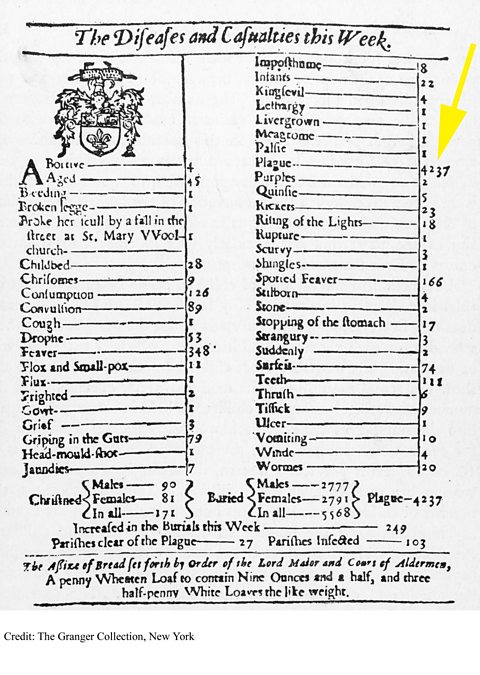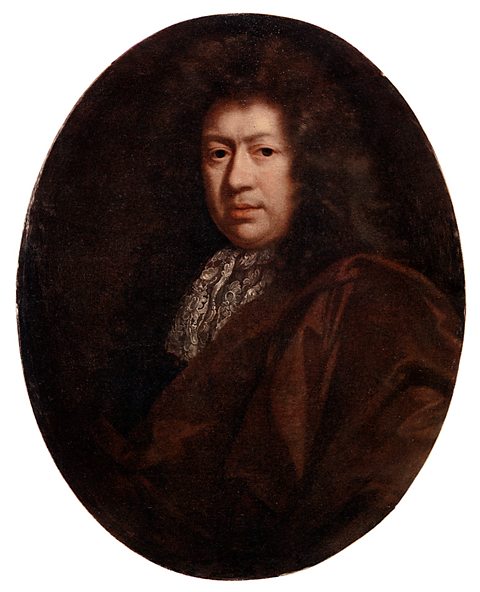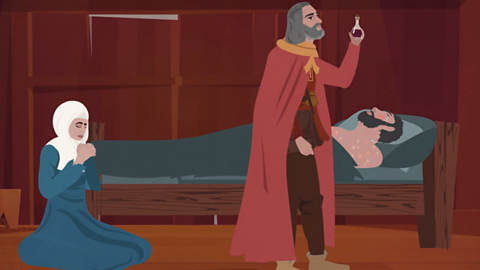Key points
The Black Death killed many people in the 1340s and 1350s. In 1665, another plague outbreak arrived in England. This is often referred to as the âGreat Plague.â
During the outbreak of 1665 - 1666, 68,596 deaths were recorded in London alone, while thousands more across the country died from the plague.
The government took some action to limit the spread of plague, though there was still little understanding of how people caught the disease.

What was the plague?
During the Great Plague, people noticed that different strains of the plague caused different symptoms. We now know that there are three types of plague: bubonic plague, pneumonic plague and septicaemic plague.
Bubonic plague was spread when people were bitten by fleas, which lived on rats. The mortality rate of people who caught bubonic plague was approximately 1 in 3. This meant that for every 100 people who caught the plague, approximately 33 might die. This plague caused large swellings, known as buboes, in the armpit, groin and neck. Most people infected with plague during the 1665 outbreak had bubonic plague.
Pneumonic plague is spread from person to person through air droplets. In the period before antibiotics were developed, this had a near 100% mortality rate, meaning that nearly everyone who caught it died.
Septicaemic plague was also spread by flea bites, causing a serious infection in the blood. This form of plague is the rarest and most serious strain of the disease.
The plague returns
In 1665, the plague returned to England. This was the first major outbreak since the Black Death of 1348 - 1349. The outbreak in London was particularly bad. 68,596 deaths were recorded in the city, though the true figure is likely to be over 100,000, as not all of the deaths were recorded.
We know a lot about the outbreak from written evidence. This includes information from the government, who set out rules to try and limit the spread, as well as accounts of what it was like to live through the plague. The diary of Samuel Pepys, who lived in London at the time of the outbreak, is a very valuable source for historians.
We also have some idea about the number of deaths because Bills of Mortality were produced. These were records, produced each week, recording the causes of deaths. At its peak in 1665, 7,000 people a week were dying from the plague.

The number of cases in London caused huge concern. King Charles II left the city and stayed in Oxford. From October 1665, Parliament relocated from London to Oxford. Wealthy people who could afford to move out of the city also fled. This included doctors, which reduced the number of skilled people available to treat plague victims. People trying to flee the plague also contributed to its spread. The Mayor of London stayed in the city, and tried to come up with ways to stop the spread. He made sure enough searcherPeople who were hired by the authorities to find and examine dead bodies, work out how they had died, and take them to burial pits. This role was mainly carried out by women. were appointed to identify plague victims, as well as ensuring food supplies were maintained so people would not go hungry.
Other efforts were made to try and prevent the plague from spreading further. For example, the border between Scotland and England was closed, and trade between London and other towns was banned.
What was the role of women during the Great Plague?
Many searchers were older women. The work was poorly paid and potentially dangerous, as it brought them into close contact with people infected by the plague. The work of searchers meant that Bills of Mortality could be produced. These gave the government of the time and future historians a clearer understanding of the impact of the plague on England's population.
During the seventeenth century, women were also responsible for a lot of medical care. They administered herbal remedies, which had been passed down through generations.
Where else was affected by the Great Plague?
London was not the only place in England to suffer an outbreak of the plague. One of the worst affected locations beyond London was Eyam, a village in Derbyshire.
Historians believe that the plague arrived in the village when a box of cloth was delivered from London to Alexander Hadfield, who was the local tailor. This cloth was infested with fleas; when Hadfieldâs assistant opened the box he was bitten and died shortly after, along with other members of his household.
From May 1666, the villagers tried a number of different things to prevent the spread of the disease. One of these measures required families to bury their own members who had died of plague, while another saw church services relocated to outdoor spaces, so that churchgoers could be kept apart. The whole village was placed into quarantineA place or period of time where people spend time on their own if they have come into contact with a disease that could be spread to others, to try and limit the spread of the disease. to try and contain the outbreak.
Some historians have suggested that up to 80% of Eyamâs residents died from plague, though the precise population of the village is not known. The church in Eyam has records of 273 people who died from plague.
Beliefs about the causes of the plague
Although people did have some idea of how they might limit the spread of plague, such as keeping people apart and quarantining sick people, there was still very limited understanding about the causes of the plague. In the 1600s, it was not yet widely understood that germs caused diseases. Instead, people believed that there were several possible causes of the plague, such as:
- miasmaAn unpleasant smell. At the time of the Great Plague, many people believed that disease was caused by foul-smelling âvapoursâ that were released by various different kinds of waste, including animal corpses and rotting food.
- an imbalance in the four humoursIn ancient times, doctors believed that there were four substances that made up the human body: black bile, yellow bile, phlegm and blood. When these were out of balance then people would be ill.
- cats and dogs living on the streets
- a punishment from God
These ideas about what was causing the plague help to explain some of the actions taken by individuals and the government to try and stop its spread. People did have some idea that plague could be spread from person to person, but they did not fully understand why this was.
What action was taken to prevent the plague from spreading?
Evidence produced at the time of the Great Plague gives us useful information about what people did to try and prevent the plague from spreading. Some actions taken by the government included:
Instructing fires to be lit in the street, so people could breathe in the smell of smoke, rather than the miasma believed to be causing the disease.
Cats and dogs were killed, as it was believed that they might spread the plague. It is estimated that 40,000 dogs and 200,000 cats were killed.
Plague victims were locked in their houses for 40 days and a red cross was painted on their door. Watchers were employed to make sure people didnât leave.
Searchers had the job of entering the home of suspected plague victims to search for bodies, and removing them to be placed in plague burial pits.
Public gatherings were banned, and people were not allowed to travel from one town to another unless they had a certificate proving they didnât have plague.
Some people took action on an individual basis to try and protect themselves from catching the disease:
Some people, particularly searchers, who were responsible for collecting the bodies of plague victims, decided to smoke tobacco. It was believed this would protect them against plague, which was completely incorrect.
Some people placed money in small pots of vinegar when paying for goods to avoid touching it directly from someone else.
Samuel Pepys' diary

Samuel Pepys was a Member of Parliament and worked for the Navy. He lived in London during the Great Plague outbreak, and kept a very detailed diary in which he recorded his thoughts about several important historical events, including the plague outbreak and the Great Fire of London. His diary was eventually published for the first time in the 19th century. Below are some of his diary entries from the time of the Great Plague:
7 June 1665
Today, I saw two or three houses marked with a red cross upon the doors, and âLord have mercy upon usâ written on them; which was a sad sight to me, as it was the first time I had seen this. It made me nervous.
29 June 1665
This end of the town every day grows very bad of the plague. The Mortality Bill is come to 267.
30 June 1665
There are great fears of the sickness here in the city, it being said that two or three houses are already shut up. God preserve as all!
4 September 1665
Writing letters all the morning, among others to my Lady Carteret⊠telling her the state of the city and other sad stories. It troubled me to walk past Coome Farm, where about 21 people have died of the plague. It is three or four days since I saw a dead body in a coffin lying unburied, and the watchers look at the houses all night, to make sure people stay in. The plague is making us as cruel as dogs to one another.

What can you learn about the Great Plague outbreak from Samuel Pepys' diary?
Pepysâ diary is an extremely useful source for historians, as it is a first-hand account of living through the Great Plague outbreak. One of the things that you might spot in this source is:
- Pepys thought that living through the plague was making people âas cruel as dogs to one anotherâ. From this, we could infer that there was a lack of collective spirit in dealing with the plague outbreak among communities in London.
What else can you find in this source?
What brought the outbreak to an end?
Many people believe that the Great Fire of London brought the plague epidemic to an end. However, historians have found that case numbers had already dropped significantly by the time of the fire. It is more likely that the cold winter of 1665 - 1666 was responsible for killing off rats, which reduced the number of plague cases.
Consequences of the Great Plague outbreak
68,596 deaths were recorded in London, with the true number likely to be over 100,000, and many thousands more across the country were killed.
Businesses and shops suffered badly because plague victims and their families were locked up in their homes, so less money was being spent.
Some historians have suggested that many towns and cities recovered from the plague outbreak fairly quickly, and that the economy continued to grow.
Test your knowledge
Play the History Detectives game! gamePlay the History Detectives game!
Analyse and evaluate evidence to uncover some of historyâs burning questions in this game.

More on Medicine through time
Find out more by working through a topic
- count1 of 2
